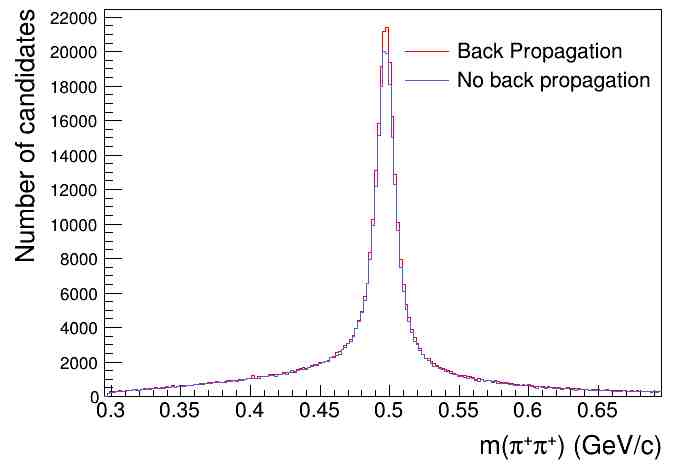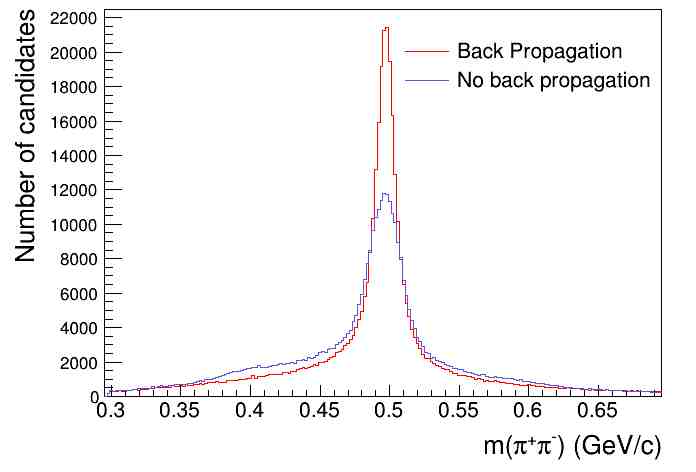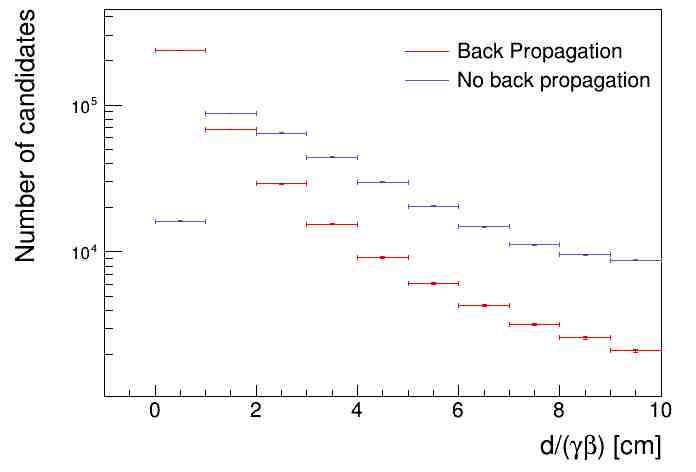Home » PANDA » PandaRoot » Analysis » No back propagation to IP for V_0 reconstruction
| No back propagation to IP for V_0 reconstruction [message #17611] |
Tue, 02 December 2014 15:29  |
 donghee
donghee
Messages: 385
Registered: January 2009
Location: Germnay
|
first-grade participant |
From: *kph.uni-mainz.de
|
|
Hello,
I am looking for K_s reconstruction with two different cases, when back propagation to IP is switched off and on case.
As a first attempt, a K_s sample in the pbarp -> D^{0}D^{0}bar -> K_s pi+ pi- + X reaction are considered at c.m.s = 3.8 GeV.
In reco macro, one can control IP back propagation by
Quote:
recoKalman->SetTrackInBranchName("SttMvdGemTrack");
recoKalman->SetPropagateToIP(kFALSE);
recoKalmanFwd->SetTrackInBranchName("FtsIdealTrack");
recoKalmanFwd->SetPropagateToIP(kFALSE);
After track reconstruction, K_s mass distributions are compared, no PID has been applied and same statistics are simulated.
MC truth matched mass distributions are plotted to see the size of efficiency.
Red histo is for the propagation turns on, the efficiency is found to be 0.406192
Blue histo is for the propagation turns off, the efficiency is 0.388105

"No back propagation" in track reconstruction doesn't help too much to repair V_0 track.
For lambda case one suggest some improvement of lambda reconstruction, but I cannot see any significant advantage for K_s case.
Best wishes,
Donghee
[Updated on: Tue, 02 December 2014 15:30] Report message to a moderator |
|
|
|
|
|
|
|
| Re: No back propagation to IP for V_0 reconstruction [message #17623 is a reply to message #17616] |
Wed, 03 December 2014 23:17   |
 donghee
donghee
Messages: 385
Registered: January 2009
Location: Germnay
|
first-grade participant |
From: *dip0.t-ipconnect.de
|
|
Hi Stefano,
Option for back propagation are touched in both reco & pid macro as you suggested.
After track reconstruction, K_s mass distributions are compared, no PID applied and same statistics are simulated.
MC truth matched mass distributions are plotted to compare directly efficiency.
Red histo is for the propagation turns on, eff=0.407035
Blue histo is for the propagation turns off, eff=0.403639

Mass resolutions are completely different, no back propagation show much worser resolution than back propagation case. This is easy to understand.
However the efficiency doesn't change.
A distance/(gamma*beta) distributions for MC truth matched k_s are compiled to test V0 reconstruction, whether "no back propagation" show some improvement of tracking efficiency for V0 decay particle. Distance is defined as a length between k_s production and decay vertex.


Naively, I expected that efficiency should also increase with "no back propagation", since the decay particles produced far from IP can be reconstructed much better than "using back propagation". In middle range in normalized distance distribution, you can see a significant improvement of reconstruction efficiency for "no back propagation". But if k_s decay near the position of produciton vertex, the efficiency drop down drastically for "no back propagation"(see zoom plot at d/(gamma*beta) below 1(cm)).
I don't know correctly why 0-1 region show a huge difference.
Best wishes,
Donghee
[Updated on: Wed, 03 December 2014 23:19] Report message to a moderator |
|
|
|
|
|
|
|
|
|
|
|
|
|
|
|
|
|
|
|
| Re: No back propagation to IP for V_0 reconstruction [message #17642 is a reply to message #17638] |
Sat, 06 December 2014 16:53  |
 StefanoSpataro
StefanoSpataro
Messages: 2736
Registered: June 2005
Location: Torino
|
first-grade participant |

From: *ip71.fastwebnet.it
|
|
I try to expain why I suggested Karin to remove the backward projection.
If you take track parameters from the first point of the track and back propagate them toward the interaction point, if the particle started far from the IP it is possible that the propagation does not converge and the track flies far from IP. In this case Geane will fail, and the track will not be processed.
We have two kinds of backpropagation: the first is in the kalman, since you want to consider in the fit the first detector hit (if you start the kalman filter from the first hit, such hit will not be used by the kalman since of course the track will sit there. If you start a bit far, like in the I.P., then you can use also that hit).
The second is in the PndPidCorrelator, since you want to have the track parameters where probably the reaction occurred (the IP), and not in the first hit (MVD in general). This is due to the fact that most often all the tracks come from the IP.
Then, in case of lambda skipping the back propagation improved the efficiency, sicne all these rejected tracks were properly computed. In case of K0S maybe they are closer to the IP and the backward propagation does not affect so much the global efficiency. moreover, if you start the kalman from the first hit, then your efficiency will be a bit poorer due to the mising hit in the fit. In case of lambda at the end you gain anyway, in case of KoS maybe you don't gain and you just loose.
I hope now the global scheme is more clear. we need some systematical study, I have some idea on how to improve for the kalman backpropagation, but I need some Guinea pig ... 
|
|
|
|
Goto Forum:
Current Time: Thu Dec 18 10:19:59 CET 2025
Total time taken to generate the page: 0.00833 seconds
|
 GSI Forum
GSI Forum



